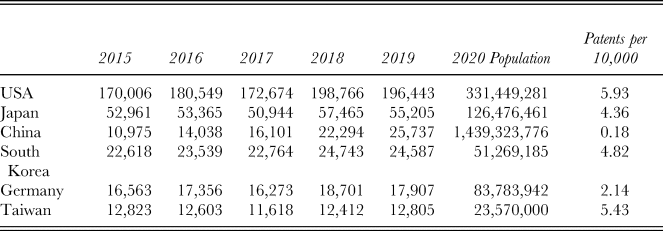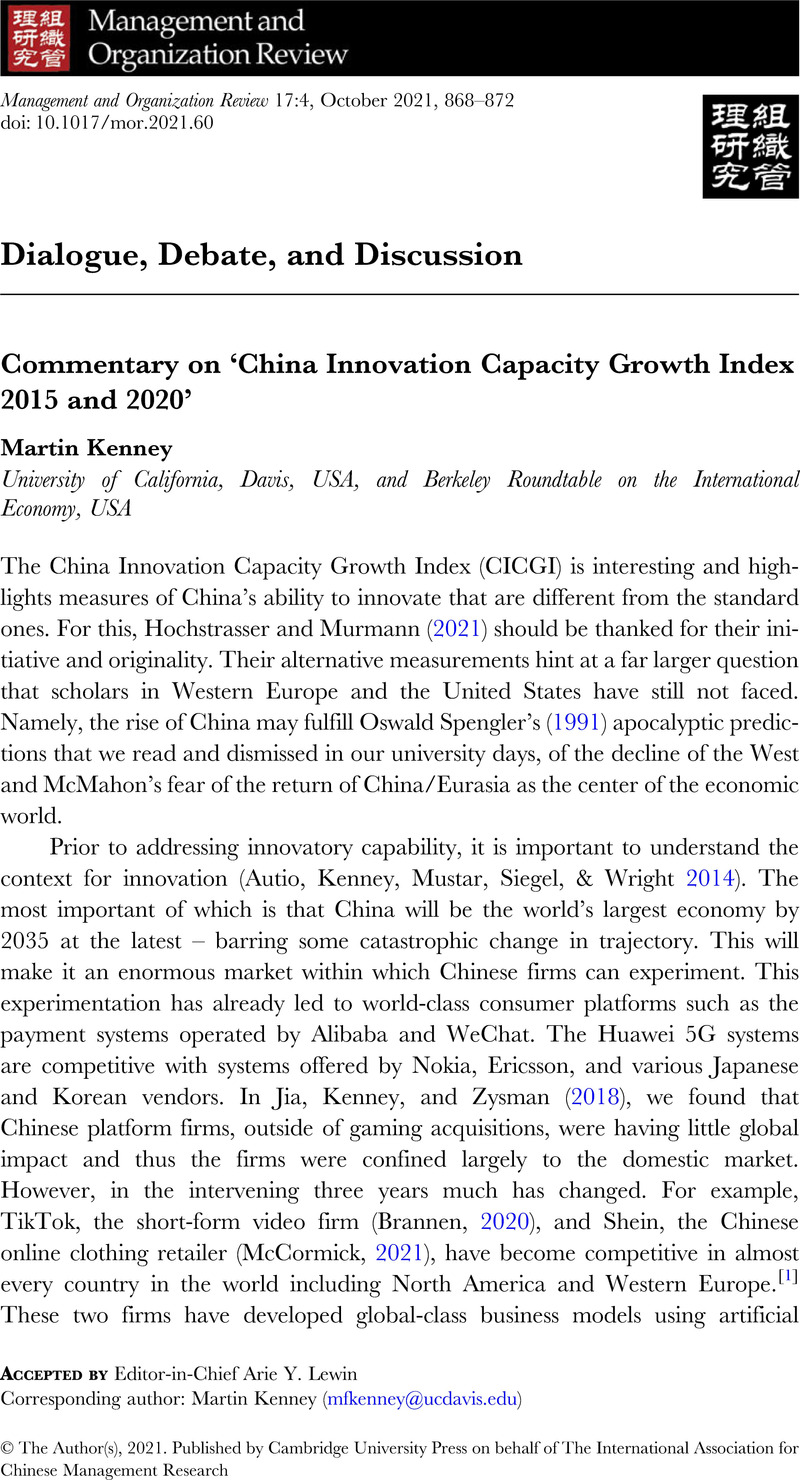The China Innovation Capacity Growth Index (CICGI) is interesting and highlights measures of China's ability to innovate that are different from the standard ones. For this, Hochstrasser and Murmann (Reference Hochstrasser and Murmann2021) should be thanked for their initiative and originality. Their alternative measurements hint at a far larger question that scholars in Western Europe and the United States have still not faced. Namely, the rise of China may fulfill Oswald Spengler's (Reference Spengler1991) apocalyptic predictions that we read and dismissed in our university days, of the decline of the West and McMahon's fear of the return of China/Eurasia as the center of the economic world.
Prior to addressing innovatory capability, it is important to understand the context for innovation (Autio, Kenney, Mustar, Siegel, & Wright Reference Autio, Kenney, Mustar, Siegel and Wright2014). The most important of which is that China will be the world's largest economy by 2035 at the latest – barring some catastrophic change in trajectory. This will make it an enormous market within which Chinese firms can experiment. This experimentation has already led to world-class consumer platforms such as the payment systems operated by Alibaba and WeChat. The Huawei 5G systems are competitive with systems offered by Nokia, Ericsson, and various Japanese and Korean vendors. In Jia, Kenney, and Zysman (Reference Jia, Kenney, Zysman, Tulder, Verbeke and Piscetello2018), we found that Chinese platform firms, outside of gaming acquisitions, were having little global impact and thus the firms were confined largely to the domestic market. However, in the intervening three years much has changed. For example, TikTok, the short-form video firm (Brannen, Reference Brannen2020), and Shein, the Chinese online clothing retailer (McCormick, Reference McCormick2021), have become competitive in almost every country in the world including North America and Western Europe.[Footnote 1] These two firms have developed global-class business models using artificial intelligence and introduced remarkably ‘addictive’ websites. Simply put, in this cutting-edge industry, China's innovation capability increasingly appears to be global class – to the point where the US government is considering ways to prevent Chinese apps from capturing the US market.
To be clear, the CICGI is an alternative index that does not incorporate more traditional indices and this is to be applauded. But it is important to consider some of the more traditional measures. For example, patents are a well-accepted innovation indicator. Instead, Hochstrasser and Murmann (Reference Hochstrasser and Murmann2021) suggest that we should consider the improvement in the intellectual property (IPR) system – here we do not enter into the increasingly strident discussion of whether the US IPR system is the best for encouraging innovation (Jaffe & Lerner, Reference Jaffe and Lerner2011). This is an important debate because the CICGI has an implicit assumption that convergence on the Western IPR regime is desirable.[Footnote 2] This convergence may happen only in part. For example, Prud'homme, Tong, and Han (Reference Prud'homme, Tong and Han2021) find that China may have different stakeholders and they may have different goals than Western IPR holders and, while this may evolve, the trajectory might be in a different direction (see, also Kenney, Reference Kenney2017). Further, as the Chinese economy becomes stronger, they may simply not accept Western norms of what is proper.
Let us consider the presumption that China's performance would be improved if it moved more toward Western norms. One measurement could be the changes in the number of patents filed by Chinese inventors at the US Patent and Trademark Office. In Table 1, one can see the patents per 10,000 citizens in the top six (by number) patenting countries. As can be seen, US performance is excellent. However, if we compare China to other East Asian countries, it dramatically under-performs other nations by an order of magnitude. Still, Chinese patenting at the USPTO has increased by 250% in five years. More important, consider how many patents China would file if it grew to only 1.7 patents per 10,000 – it would file 250,000 patents per year, outstripping the US. Given the acceleration in Chinese investment in R&D, the growing market, and the growth of large and increasingly sophisticated firms, this should be possible over the next two decades. If one has a longer perspective and assumes that the politics of the Chinese state will not block further growth, China is likely to swamp the US in terms of patents filed. In terms of innovation, China is, almost certainly, destined to become a powerful innovative nation.
Table 1. US PTO patents granted 2015–2019, population, and patents per 10,000 by top six patenting nations

One of the measures in the CICGI is university independence. In fact, the CICGI suggests that China's university independence has decreased and that this is a problem for the improvement of Chinese innovation. This conclusion is, perhaps, justified. However, the improvement of Chinese universities’ international rankings is undeniable. If we use the Academic Ranking of World Universities, we see that in 2021 China had 71 universities in the top 500 globally, as compared to the 133 US institutions. In comparison, in 2010, China had 34 universities in the top 500 versus the US having 154 universities (Shanghai Ranking, Reference Ranking2021). Of course, academic excellence does not necessarily lead to innovation, however, the linkage between university excellence and innovation is incontrovertible.[Footnote 3] So, perhaps, the lack of university autonomy will hamper further improvement in Chinese innovation, but we cannot yet see this problem in terms of Chinese university improvement.
The CICGI uses SOE's role in the economy as another indicator of innovation. The increasing importance of SOEs is used as indicator of problems in the Chinese innovation system. Ten or twenty years ago, I would have been comfortable with this indicator. However, more recently, certainty about the proper role of the state in key industries has wavered, as scholars and policy-makers reconsider deregulation and wholesale privatization. It is clear that SOEs own and operate much of the key Chinese infrastructure and, in some cases (e.g., banks), are enormously profitable. Are SOEs a problem, if, for example, they finance and operate state-of-the-art infrastructure, such as 5G networks and world-class transportation systems, all of which create internal markets and facilitate learning-by-doing types of innovation? Moreover, this infrastructure can operate with low-profit margins, thereby providing a base upon which private sector actors can innovate. Chinese success in terms of providing low-cost bandwidth or, for electric vehicles, low-cost electric power seems to argue that efficient SOEs can be powerful innovation accelerators. While I am agnostic on the issue, it is vital to accept that different systems may devise different political-economic institutions that can contribute to societal-level innovatory behavior.
One final observation prior to closing. It seems nearly certain that the end of the European and European settler state's reign as the unquestioned technological and innovation leaders is within sight. Chinese success suggests that traditional so-called ‘universal’, i.e., Western notions of innovation and economic growth, must be reconsidered. The fact that this change may be possible suggests that we may need new ways of measuring innovativeness. For this, Hochstrasser and Murmann (Reference Hochstrasser and Murmann2021) are to be congratulated for developing and pursuing the updating of their innovation index.
One task ahead is to hone the innovation index to be more based upon the Chinese experience and unbiased by Western preconceptions about what ‘works’. For example, in the early phase political stability might be a strong indicator of the development of an environment conducive to building catch-up. However, after catch-up, it may be necessary for the nation's institutions to evolve further (Malerba & Lee, Reference Malerba and Lee2021), though this does not necessarily mean adopting an entirely new recipe. Can we fashion indices that provide measurements mindful of different recipes for achieving success?
To reiterate, Hochstrasser and Murmann (Reference Hochstrasser and Murmann2021) should be congratulated for this updating of their alternative index, in part, because the index hints that it might be time to move beyond traditional measures of innovatory potential and search for new indicators suited to a world where the preponderance of economic growth and innovation occurs outside the nations that have led the way for the last three centuries. For those intent upon understanding China's innovation trajectory/ies, and, perhaps, for the other nations that might soon emerge, understanding the contexts and motivations will be vital for measuring their innovative progress. Put bluntly, echoing Graham Allison (Reference Allison2017), I submit that over the last two decades, we have been living through a change that resembles what, in the two centuries ending in roughly 1850, the Europeans lived through when Europe and the European settler states became the dominant world economic powers.







Target article
China Innovation Capacity Growth Index 2015 and 2020
Related commentaries (2)
Commentary on ‘China Innovation Capacity Growth Index 2015 and 2020’
Measuring China's Innovation Capacity: An Important Unmeasurable Factor and a New Contextual Factor